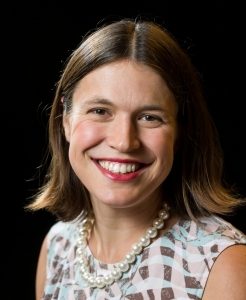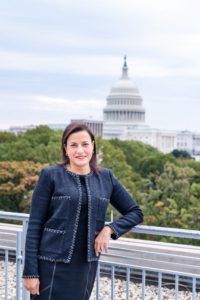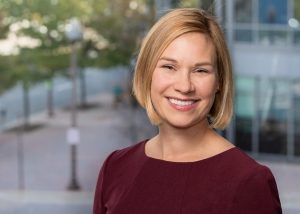Our Spotlight on Flex showcases professionals from member organizations who exemplify personal and professional success while working a flexible schedule. Their stories illustrate the long-term benefits that flexible schedules offer to both individuals and organizations.
2020 Spotlights
For February 2020, we are pleased to share insights from Meg Kedrowski Managing Director & Partner, Boston Consulting Group (Los Angeles, CA)
DFA: How have you made flexibility a priority and a success with your schedule?
 MK: Boston Consulting Group (“BCG”) is a dream job for me. I love the impact and variety of our projects and the caliber of our talent. I started as an associate, then consultant to project leader, was promoted to principal, and then again to my current role as a managing director and partner in 2018. BCG has been so supportive every step of my career – between transferring offices twice because of my husband’s career and working at a reduced [hours] capacity. A year into my role as a project leader in 2012, I switched to a flex schedule – this was even before I had kids. I had been at BCG for five years, was traveling extensively, and working a lot of hours. I was at the point where I was jealous of my friends at other jobs who had time during the week (not just the weekends) to do the things they enjoyed. I wanted that option too. But I struggled with how to achieve that work/life control when my colleagues were working more than that. I didn’t think it was fair to change my schedule when the rest of the team was counting on me. I have a background in economics, and after looking at the amount of hours/week I was putting in, I realized the marginal cost to me personally, of each additional hour past 40 hours/week, was a lot higher than the marginal cost of the first 10 hours I worked. I wanted to optimize on the margins; I was willing to give up 20% of my pay in order to shed 20% of the hours that had the highest personal cost to me. In other words, I wanted to work at an 80% capacity by being in the office five days a week, leaving early to be home and have dinner with my husband, and not worry about opening my laptop in the late evening hours. Of course, there were times I had to stay late or meet with clients, but it was an absolute step change in my relationship with managing work and life. I’ll be honest; I didn’t think a reduced schedule was going to work at first. But I needed to make a change. My partners were extremely supportive, clients knew about my schedule change, and BCG put extra resources on my teams so coverage was always in place. I was able to turn down certain projects with confidence that it wouldn’t impede my advancement. In 2013, I had my first child, and I probably would not have come back to work at BCG if I didn’t have flex options in place. I’ve made flex work for me as needed during different stages in my career and life. I was a principal when I had my second child, and I started dividing my time between multiple client projects. But it wasn’t feasible to work five shorter days a week with this arrangement. Instead, I switched to taking one day a week off (either Wednesdays or Thursdays). After my third maternity leave, I went to a 60% reduced capacity schedule and ramped back up to 80% with one day a week off. However in 2018, I took a medical leave of absence; when I returned to work, I went back to 60% reduced capacity, with two days off per week. I’ve been on this schedule ever since. Nothing is set in stone – some weeks I need to switch which days I’m out of the office or some weeks I have to bank my time off for another week. The most important thing is that I work with my team to make sure there’s coverage for our clients. It’s flexible flexibility.
MK: Boston Consulting Group (“BCG”) is a dream job for me. I love the impact and variety of our projects and the caliber of our talent. I started as an associate, then consultant to project leader, was promoted to principal, and then again to my current role as a managing director and partner in 2018. BCG has been so supportive every step of my career – between transferring offices twice because of my husband’s career and working at a reduced [hours] capacity. A year into my role as a project leader in 2012, I switched to a flex schedule – this was even before I had kids. I had been at BCG for five years, was traveling extensively, and working a lot of hours. I was at the point where I was jealous of my friends at other jobs who had time during the week (not just the weekends) to do the things they enjoyed. I wanted that option too. But I struggled with how to achieve that work/life control when my colleagues were working more than that. I didn’t think it was fair to change my schedule when the rest of the team was counting on me. I have a background in economics, and after looking at the amount of hours/week I was putting in, I realized the marginal cost to me personally, of each additional hour past 40 hours/week, was a lot higher than the marginal cost of the first 10 hours I worked. I wanted to optimize on the margins; I was willing to give up 20% of my pay in order to shed 20% of the hours that had the highest personal cost to me. In other words, I wanted to work at an 80% capacity by being in the office five days a week, leaving early to be home and have dinner with my husband, and not worry about opening my laptop in the late evening hours. Of course, there were times I had to stay late or meet with clients, but it was an absolute step change in my relationship with managing work and life. I’ll be honest; I didn’t think a reduced schedule was going to work at first. But I needed to make a change. My partners were extremely supportive, clients knew about my schedule change, and BCG put extra resources on my teams so coverage was always in place. I was able to turn down certain projects with confidence that it wouldn’t impede my advancement. In 2013, I had my first child, and I probably would not have come back to work at BCG if I didn’t have flex options in place. I’ve made flex work for me as needed during different stages in my career and life. I was a principal when I had my second child, and I started dividing my time between multiple client projects. But it wasn’t feasible to work five shorter days a week with this arrangement. Instead, I switched to taking one day a week off (either Wednesdays or Thursdays). After my third maternity leave, I went to a 60% reduced capacity schedule and ramped back up to 80% with one day a week off. However in 2018, I took a medical leave of absence; when I returned to work, I went back to 60% reduced capacity, with two days off per week. I’ve been on this schedule ever since. Nothing is set in stone – some weeks I need to switch which days I’m out of the office or some weeks I have to bank my time off for another week. The most important thing is that I work with my team to make sure there’s coverage for our clients. It’s flexible flexibility.
DFA: How have the firm and/or clients contributed to your Flex Success®?
MK: I did think about leaving at one point, but after talking with other colleagues who were working reduced hours, I knew I had to try a flexible model. Once I decided on my schedule, BCG was on board. It takes some clients a little longer to understand flexible work, but once they see that their deliverables are unaffected and they’re receiving the trusted support they need, any concerns are gone. In our line of work, we bill by deliverables – not by the hour. I know there are partners who are skeptics about reduced hours. In their minds, they don’t see the need to take a pay cut in order to leave early once in a while to see their kids’ games or meet personal commitments. But the trade-offs are worth it to me. The difference between a flex schedule and occasionally leaving early to watch your kids’ games (which everyone should feel empowered to do), is the additional support and resources you have and the consistency to keep those personal commitments during the week. BCG has always focused on supporting me, making sure I’m meeting my personal goals, and that I’m fairly compensated along the way. Since my own switch to a flexible model, BCG has taken steps to formalize and simplify the process for team members. We now offer standard “Flex60” and “Flex80” programs with clear policies around how to ensure fair work schedules, pay, and promotion for individuals seeking a reduced-hours model. We also offer “Time for You,” an opportunity to take eight weeks of unpaid leave with full benefits. I hope this will make flexible models easier for others at BCG to adopt.
DFA: How has working flexibly made your career more sustainable and contributed to business/professional development opportunities?
MK: I wouldn’t be at BCG if we didn’t offer flexible work options. Working reduced hours allows me to be the kind of wife, mother, and friend that I want to be while still delivering outstanding value to clients. Many of my clients are trying to figure out their work/life balance situation too. I’ve found that when I open up to them about my schedule, it tends to be a relationship builder, not a relationship limiter. Ask yourself what you’re trying to achieve while working flexibly. If you’re shooting for something that’s unrealistic for you, your organization, or your clients, then it won’t work. Be clear on what your top priorities are, and set standards that will make you happy.
DFA: Looking back, would you do anything differently, or what would you tell your younger self?
MK: You don’t have to solve for what you need 10 years from now, because you don’t know what you’ll need 10 years from now. Things change. Solve for what you need for the next 6-12 months, and don’t close any doors that would keep you from solving for a different set of needs in a year’s time. There was a period earlier in my career (for about two to three months) where I was trying to build a new set of capabilities and working more than my agreed upon hours. In retrospect, I should have been clearer about I was trying to accomplish and engaged my mentors and partners more. I should have officially changed my hours during that time and been more deliberate and transparent with my goals. Instead, I viewed this as “a great opportunity and I can’t turn it down,” even if I wasn’t sleeping! Had I been more transparent, I would have delivered better value and been more successful at building the skill sets and relationships I wanted at the time.
DFA: How do you recharge, and how do you pay it forward?
MK: Lots of different ways! I’m an avid reader and just finished the book Light from Other Stars, a science fiction novel that’s a fascinating thought-starter on women’s career options and how the trade-offs women have had to make have changed dramatically over the last few decades. My family has annual passes to Disneyland, and we go at least once a month – it’s one of the best ways to use my day off. I’m also fortunate to live in a very walkable neighborhood; I like to walk my kids to and from school, stopping by the park and the local coffee shop. I do my best to mentor other women and men who are trying to solve their own work/life challenges. I’ve seen a significant uptick in men looking for advice too. A year ago BCG kicked off our ”Women in MedTech” initiative, and I’ve been helping lead that program. Internally, we focus on mentorship, affiliation, and ensuring diverse voices are reflected in our leadership. We team with our clients to advance women in MedTech and participate in external forums. It’s been fun to give back and be part of something that triggers thoughtprovoking discussions on diversity and gender, both inside BCG and beyond.

 Featuring
Featuring 
 AB: Before joining Squire Patton Boggs (“Squire”) in 2014, I worked at another large regional law firm and focused my practice on public finance. After my daughter was born, I changed my schedule to telecommute one day a week, but after a year, I wanted more flexibility in my schedule and more time to spend with her. That firm already had several attorneys working reduced hours, and it was clear our practice group’s partners were supportive of flexible work arrangements. I switched to an 80% reduced hours schedule and was in the office four days a week.
AB: Before joining Squire Patton Boggs (“Squire”) in 2014, I worked at another large regional law firm and focused my practice on public finance. After my daughter was born, I changed my schedule to telecommute one day a week, but after a year, I wanted more flexibility in my schedule and more time to spend with her. That firm already had several attorneys working reduced hours, and it was clear our practice group’s partners were supportive of flexible work arrangements. I switched to an 80% reduced hours schedule and was in the office four days a week. Whether you’re in a meeting, on the phone, around the proverbial “water cooler,” at a conference, or anywhere else: your ability to speak with confidence will drive your career forward — just as a lack of confidence will frustratingly hold you back. In Develop Your Professional Presence, Spoken with Authority will offer an interactive and consciousness-raising webinar experience. If you participate fully, you will gain a set of powerful insights and practical strategies that will rapidly enhance your professional presence.
Whether you’re in a meeting, on the phone, around the proverbial “water cooler,” at a conference, or anywhere else: your ability to speak with confidence will drive your career forward — just as a lack of confidence will frustratingly hold you back. In Develop Your Professional Presence, Spoken with Authority will offer an interactive and consciousness-raising webinar experience. If you participate fully, you will gain a set of powerful insights and practical strategies that will rapidly enhance your professional presence. Christine Clapp is the author of Presenting at Work: A Guide to Public Speaking in Professional Contexts and the president of Spoken with Authority, a Washington, D.C.-based presentation skills consultancy that explores the intersection of presentation skills and inclusion. Through training programs and coaching engagements, Christine and her team help professionals at law firms, corporations, associations, and non-profit organizations elevate their presence and expand their influence.
Christine Clapp is the author of Presenting at Work: A Guide to Public Speaking in Professional Contexts and the president of Spoken with Authority, a Washington, D.C.-based presentation skills consultancy that explores the intersection of presentation skills and inclusion. Through training programs and coaching engagements, Christine and her team help professionals at law firms, corporations, associations, and non-profit organizations elevate their presence and expand their influence.